WOMEN IN ENERGY MANAGEMENT AND GENDER BARRIERS


THE JOURNEY TO NET ZERO

ESOS PHASE 3 COMPLIANCE –HOW TO GET IT RIGHT

ALL WOMEN CONTRIBUTORS

www.theema.org.uk | ISSUE 1/2023 GOING NET ZERO WITH OUR EMPLOYEES TEAM INTERVIEW MY ROLE IN TACKLING CLIMATE CHANGE

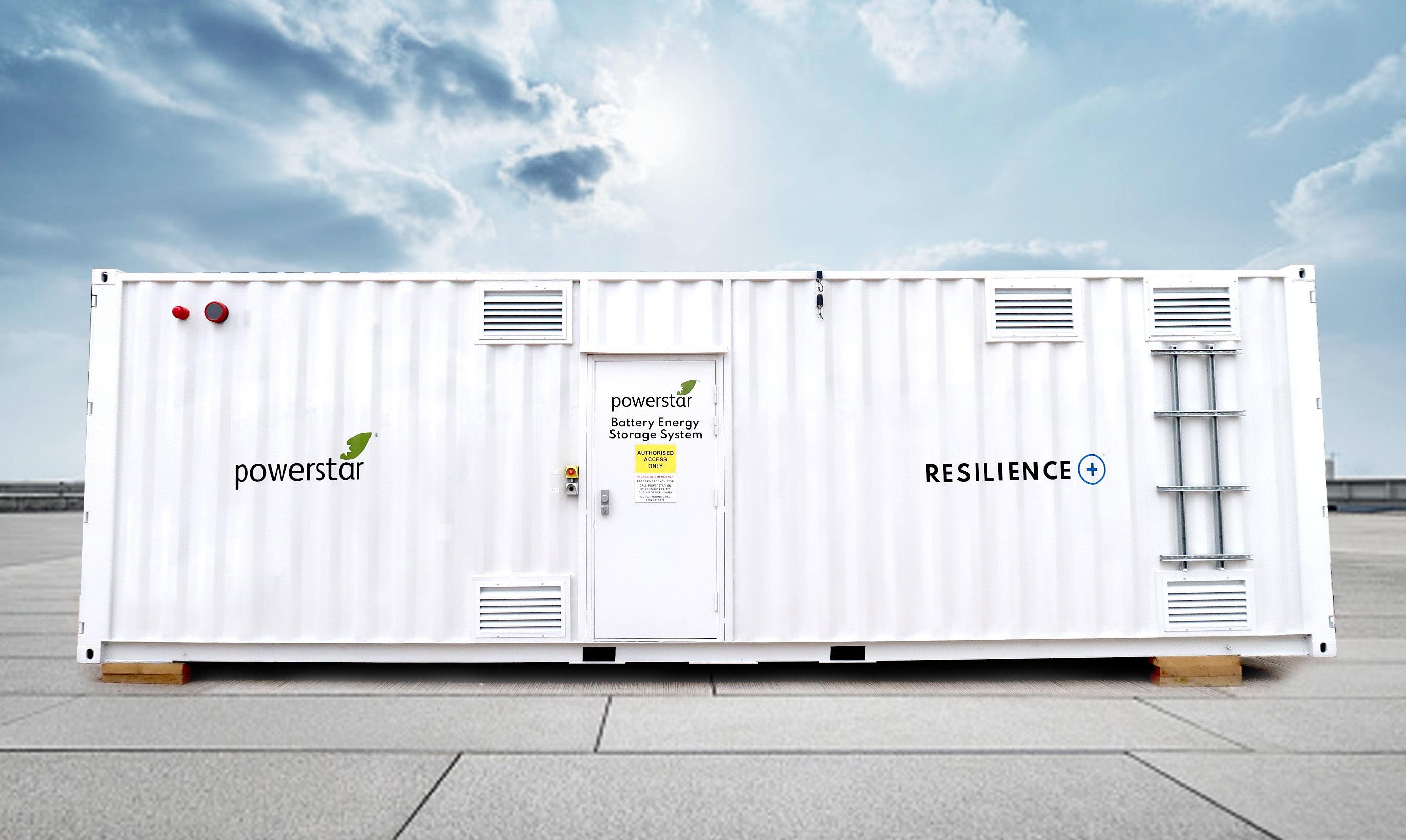








 By Lois Betts and Laura Bellamy
By Lois Betts and Laura Bellamy







 By Hayley Williams
By Hayley Williams

3 THE EMA MAGAZINE • ISSUE 1/2023 contents THE EMA MAGAZINE 04 FOREWORD By The Energy Managers Association FEATURES 06 WOMEN IN ENERGY MANAGEMENT AND GENDER BARRIERS By Rachel Feeney, Rebecca Smart and Victoria Limbrick 14 ESOS PHASE 3 COMPLIANCEHOW TO GET IT RIGHT By Emma Callicott and Abimbola Ihidero INDUSTRY FOCUS 24 GOING NET ZERO WITH OUR EMPLOYEES By Kirsty Rice 28 THE JOURNEY TO NET ZERO By
www.theema.org.uk ISSUE 1/2023 GOING NET ZERO WITH OUR EMPLOYEES TEAM INTERVIEW MY ROLE IN TACKLING CLIMATE CHANGE ESOS PHASE 3 COMPLIANCE –HOW TO GET IT RIGHT THE JOURNEY TO NET ZERO WOMEN IN ENERGY MANAGEMENT AND GENDER BARRIERS ALL WOMEN CONTRIBUTORS 14 06 24 22 CAREER & TRAINING 18 ENERGY MANAGEMENT TEAM INTERVIEW
22 MY ROLE IN TACKLING CLIMATE CHANGE
Sara Emmett
Dear Reader,
Increasing the representation of women in any industry, notwithstanding energy management, takes more than just recruiting efforts or co-ordinating and facilitating women groups. It starts with fostering an inclusive culture, improving access and opportunity for growth and advancement and amplifying the voice of women.
In this edition of The EMA Magazine, we built on the success of the previous edition backed by all-female authors, and once again strengthen the collective voice of women in energy management, associated fields and across our membership. The fact that we are able to deliver an all-women contributors edition is testament to the increasing numbers of women in the industry and their understanding and willingness to share awareness of experiences and accomplishments, all of which are demonstrated through the range of covered topics.
Experiences of female gender in energy management and associated challenges, not only observed but often experienced, will no doubt echo with many of the readers. The gender barriers might be more prevalent in some organisations than in others, but it tends to be a shared matter, and we hope that by including the topic we will raise awareness and help to abolish behaviours that have no place in a modern working environment.
Women are breaking the barriers, increasing their voice and shining the light on their expertise through bolder and inspiring means. Those we see explaining processes, actions and projects or sharing opinions on regulatory developments, send a strong and inspiring message about their roles in the industry.
Our all-female contributors take real, active and diverse perspectives and help us to think bigger, and in some cases differently, about energy management. Seeing female names in the industry that is often referred to as ‘male dominated’ does not only challenge the bias, it also champions the women in this profession and their wealth of knowledge and expertise.
We hope you will enjoy this edition at least as much as we have enjoyed compiling it!
PUBLISHER
The EMA Magazine is published quarterly by the Energy Managers Association (EMA).

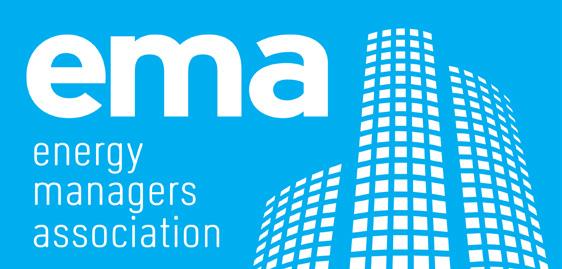
EDITORIAL
The Energy Managers Association
www.theema.org.uk
Tel: 0203 916 5516
CONTACT
Edita Krupova; Editorial Enquiries & EMA Membership Services Manager edita.krupova@theema.org.uk
CONTRIBUTORS: Rachel Feeney, Rebecca Smart, Victoria Limbrick, Emma Callicott, Abimbola Ihidero, Lois Betts, Laura Bellamy, Hayley Williams, Kirsty Rice and Sara Emmett
The EMA would like to thank to the above contributors for their time and effort in providing the content and making this issue possible. Their willingness to share experience and knowledge is exemplary and inspiring, and we hope it will encourage others to come forward and contribute in the future.
ADVERTISING SALES
The EMA Team
Tel: 0203 916 5516 enquiries@theema.org.uk
ABOUT EMA
The Energy Managers Association (EMA) was set up in February 2012 and represents Energy Managers across all industries. Our priority is to improve the position of energy management experts and their profession and act as their united voice. We aim to develop the skills, knowledge and experience of professionals through our training, high-quality peer to peer guidance and best practice exchange.
@2023 Energy Managers Association, Registered in England and Wales, Company No 7943728, VAT No 151339624, Registered Address: Suite 77, 95 Mortimer Street, London, W1W 7GB.
No part of this publication may be reproduced, stored in, or introduced into a retrieval system, or transmitted in any form or by any means (electronic, mechanical, photocopying, recording, or otherwise) without prior written permission. Any information or material sent by advertisers and contributors, including advice, opinions, drawings and photographs, is the view and the responsibility of those advertisers and contributors, and does not necessarily represent the view of the EMA.
THE EMA MAGAZINE • ISSUE 1/2023 4
The EMA Team
by The Energy Managers Association
FOREWORD
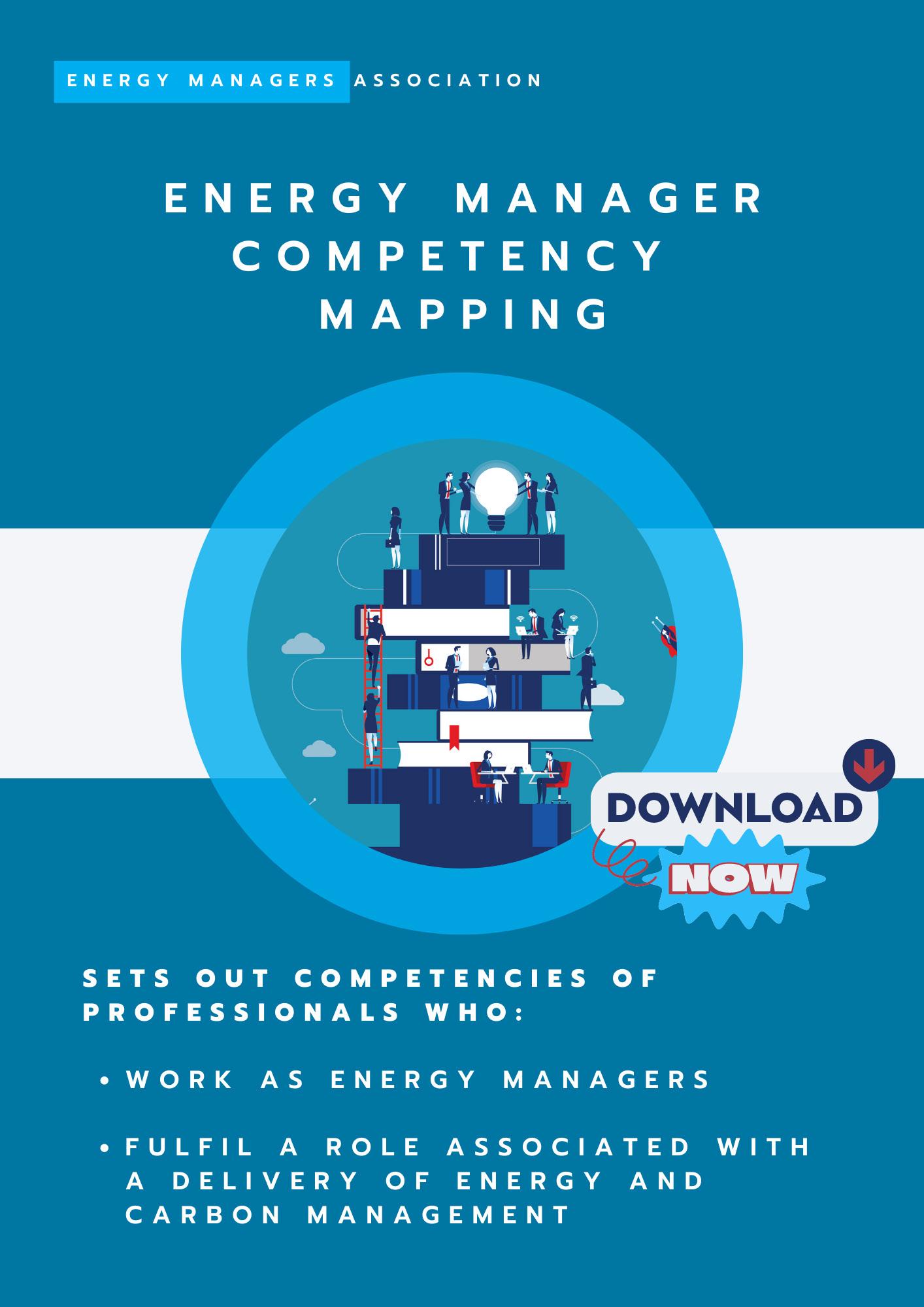 by Rachel Feeney, Rebecca Smart, Anonymous Sustainability Consultant and Victoria Limbrick
by Rachel Feeney, Rebecca Smart, Anonymous Sustainability Consultant and Victoria Limbrick
Women in Energy Management and Gender Barriers

The energy industry has one of the worst gender gaps in the working sector. Because of this, women are still finding themselves in situations that their male counterparts wouldn’t (most likely) have to go through. As women continue navigating gender barriers, they must assert themselves with power and confidence, and remember that we are all equal. Four women in energy and sustainability fields have agreed to share their experiences and reflect on how they dealt with and overcame these situations.
Rachel Feeney Energy Manager, Erda Energy

Have you had to address and overcome a situation that probably wouldn’t have happened to a male colleague?
At the end of last year, I found myself in a project handover meeting with all men, something I had grown used to after nearly 5 years in the thermal energy industry. There was a group of colleagues from my company and a group from the client’s company. As members of the meeting entered the room, we greeted each other with handshakes. One member of the client’s team entered the room and looked at my colleague and I, he proceeded to say: “I don’t think I have met you two before”, the man
shook hands with my colleague and they introduced themselves. The man then turned to me, gave me a minor acknowledgement with a head nod, and proceeded to take his seat. At first, I was confused and realised my hand was still out waiting to shake his and formally introduce myself. I proceeded to look at him with a confused and now upset look on my face. He then said, “I do not shake hands with women out of respect for my wife”.
I am respectful of religious beliefs and customs, but this was confusing to me. I was not looked at by him as a colleague but as a female and he did not treat me the same way he treated my male counterpart. I wondered what he would have done if the majority of people in the meeting had been women.
What advice would you give to other women who are experiencing similar instances?
The situation above was witnessed by colleagues and my line manager.
Although they hadn’t said anything in the moment, each one of them spoke to me about it and apologised for not speaking up. To feel the support of colleagues felt good but I also wished I had been more prepared for the situation. In the future, I will be more prepared as I acknowledge his rule but introduce myself with name and title and a response that asserts my presence.
My self-confidence comes from knowing what to expect and being prepared. Often being in rooms like this that are male dominated can be quite overwhelming but if I am prepared from a content perspective, then socially I can assert my presence in other ways that go beyond a handshake and understanding how someone treats me is their foolishness not mine.
I feel statistically, women will continue to be at a disadvantage in our industry but if we put in the hours and know the ins and outs of
THE EMA MAGAZINE • ISSUE 1/2023 6 FEATURES
our work, we will gain the respect of all colleagues no matter what gender they are. I also find that by sharing these experiences and how it made me feel helps to feel better and make colleagues aware that these types of things are still happening, and gender barriers still exist. This can serve as a reminder for colleagues to be looking out for things like this and have them prepared as well if something similar should happen in their presence.
Author’s profile:
Rachel has been working for Erda Energy, a geo-exchange solutions company, since 2018 and has recently been promoted to Energy Manager. Rachel has a passion for the environment and helping clients get closer to Net Zero goals. She lives in London and loves trail running in the Surrey Hills.

dismissive or disparaging comment that, whilst not intentiona lly being so can undermine the significance of an issue being discussed or a
with others are key to creating a positive culture. Together, these are leading to positive changes for women in the industry.
Rebecca Smart Energy Projects Support Officer
Have you had to address and overcome a situation that probably wouldn’t have happened to a male colleague?
Having worked in Energy Management for just over 6 years, I am pleased to say that I haven’t had any experiences in which my gender has impacted my career aims or my work goals. I have always worked in supportive environments. However, as may be common in many other industries, I have experienced an occasional
point I am raising. The unintended consequence is that you could find yourself working harder than a male colleague might otherwise have to in order to convey the same message. Of course, this isn’t specific to gender only – my comparatively young age and the fact that I am relatively early in my career may have also played a part –but in common with other women, you can’t help but consider the role of gender in the interaction.
Encouragingly, such circumstances are rare. I believe one of the reasons for this is an increase in awareness of issues such as unconscious bias. Additionally, an increased number of women in the industry gives us role models which, in turn, helps us to be more confident in our expertise and in conveying that expertise. At the same time the environment in which we are working is becoming more aware of the importance of how interactions
What advice would you give to other women who are experiencing similar instances?
Working in Energy Management offers us all, both women and men, the advantage of working with facts and figures – this affords us the opportunity to back up our ideas and points with this information. One of the reasons I enjoy working in Energy Management is the clarity that data can provide. I have found that it is a useful tool to lean on when needing to highlight a point and put across my message. This can be particularly beneficial in the face of dismissive comments or if you feel you are not being listened to; the data can offer proof.
I previously mentioned an increase in awareness of unconscious bias and I have found that speaking with colleagues openly to discuss this has given interesting opportunities to hear different perspectives and

7 THE EMA MAGAZINE • ISSUE 1/2023
experiences, and also to foster a more open and positive work culture. Work places can often mean interreacting with people outside of your usual peer group, and by speaking with different people you can widen your own (and others’) horizons and understanding.

In the case of potentially harmful comments it is difficult to give advice on these types of instances generally as I think they can be so dependent on the particular circumstances – such as how well do you know the relevant individual making the comment; is it a formal or informal context?; are other people present? However, if a situation arises that you would like to address, I would advise approaching the person privately, calmly and openly. Not only will this help your confidence, but it will also help the person understand why their comment may have been inappropriate.
Author’s profile:
Rebecca leads on the ISO 50001 and ISO 14001 certifications at her organisation where she manages and reports on energy
consumption, energy and environmental compliance and has a role in energy procurement and finance.
Proof is in being able to understand the requirements and deliver for your business and client, if you can do this then the need for qualifications recedes compared to experience.
Sustainability Consultant Retrofit Sector
Have you had to address and overcome a situation that probably wouldn’t have happened to a male colleague?

I’ve worked in the construction sector for around 22 years. Some of this was in commercial fit-out and in the last 12 years in the sustainability/retrofit sector. I didn’t start my career with a constructionbased qualification but without giving a personal history, Architecture should have probably been my chosen career path and this was evident from age 15/16. Stepping into the sector without an obvious line of knowledge was daunting and I faced a number of challenges from men and women.
I moved into Sustainability because my interest is circular, design, buildings, environment, and this I think is a constant in my career history. I studied Geography as an undergraduate, and this touched on certain elements, as it is essentially a systems approach of looking at the problems facing our wider environment. As geographers, we are well placed to consider ‘systems’ and find ways of improving them. Of course, there is more to it than that, but let’s just place that within the context of this article.
In one position I held in my early design career, I was ‘caught’ reading the classifieds at the end of the working day. My director asked me to join him in his office and asked why I was looking for another job. I explained that I couldn’t afford to make ends meet on the salary I was employed on (1998 - £10k) and that I needed to supplement my income with an evening job. He
THE EMA MAGAZINE • ISSUE 1/2023 8
wasn’t happy about me working two jobs in case I was needed to pull a drawing package together at the last minute and work late. His comment to me was: “Oh, I thought that you were doing this for pocket money and that your partner paid for everything else”. In reality, I shared the cost equally with my partner – he earned more than me so that was not an equitable division of costs.
In this same role, I was often the only female at project/site meetings. As a junior at the time, these were often quite daunting, but I was learning a lot about construction and project delivery at the same time. However, there were areas where I was a) leading (design) and b) dealing with other common-sense items that anyone could potentially answer. Many a time, I would either say something in response to a question or someone else’s comment only to be ignored by the whole table, and the man next to me picking it up shortly after as his own idea and be lauded (often – not always) for the comment or idea. Or the alternative was that I was ignored when raising issues several times, and then when I raised my voice to be heard, I was looked at with a derogatory expression! Of course, this is my interpretation of the situation. The scenarios played on many occasions.
Forward wind to the sustainability experience, I completed a masters in 2011, before my first employed position in the ‘retrofit’ industry. This time I came with the knowledge, though little direct experience of the industry, but still with 10 years of working in construction, designing and managing projects. My experience was often discounted, I think the term ‘interior designer’ in the sustainability sector was akin to working on Changing Rooms
many great administrators, some with specific knowledge of a sector and others with knowledge of how to make projects work in the public sector – both important skills. However, with some contractors I believe seeing a woman, or perhaps female led team might seem like they are of the latter type rather than the former. I have so many experiences of mansplaining within this context that it’s hard to pick a specific one out. What I can say for sure is that in most instances I was far more educated on retrofit, building physics and taking a holistic viewpoint than the contractors I was working with.
(a programme that ran through the 90s and has recently been resurrected). Never a question of what this might have entailed, or where the cross over in experience might have been – so perhaps also a failing of my sustainability colleagues to ask the questions? Somehow my experience was seen as frivolous, again my interpretation of the situations. Would this have been the same for a male designer?
Working in a local authority context you are generally there to administer programmes. There are
In one particular instance, we were asked by our delivery contractor whether they could install internal wall insulation on the programme. Given the inherent risks associated with getting this right, and the many potential unintended consequences of not, I raised my concern. At the time my manager, also in the meeting, was male and he said to the contractor that they could, if they were able to, do Wufi modelling to prove that we wouldn’t have unintended consequences. The contractor hadn’t heard of Wufi. This theme continued, my line manager moved on and I had a female line manager. I was continually ignored by the contractor as they sought approval from my line manager who, not being technical, wasn’t able to give

9 THE EMA MAGAZINE • ISSUE 1/2023
them a coherent answer. Internal wall insulation was not installed which was lucky as the contractor went into administration within 12 months. Thankfully, we did not have customers with half their plaster missing in the front room. At the same organisation, whilst working as an Installations Manager, I was told by the Project Director at one of the contractors that they were unable to get flue extensions for 5 boilers and therefore they would need to leave a 300mm uninsulated section around the flue – thus creating a massive thermal bridge. I said that it wasn’t acceptable and was told that he’d been doing this for 17 years and I was effectively the first to challenge what he was saying (no idea if that was true) but basically, he knew what he was talking about, and I should definitely just follow his lead. I asked him if he could give me the make and model number of the five boilers as I would like to check with the manufacturer why we couldn’t get extensions for these models. The contractor responded angrily, shouting: “Are you calling me a liar?!” To which I responded, no, I just want to make sure that we had all stones unturned (inside I was shouting – ‘no, I’m calling you out!’ but of course decorum meant that I didn’t make this statement). A week later, at the next progress meeting there was only one flue extension that couldn’t be sourced.
Funny that!
The regularity of this type of response got to the stage where I could attend a contract start meeting and probably know within the first 5 minutes of how the contractor reacted towards me as to how they would treat my knowledge and understanding, and capability to do the job as we moved into the contract. And equally as predictably, I could determine that at some point in
to anyone else. My colleague, my line manager at the time, was a man and the same age, clearly, he wasn’t past it. These are just some examples.
I would also highlight that I have also been treated differently to how men would be treated by women in positions of power or as a client or project partner. It is not a oneway street and women need to be aware of their own gender bias (along with all the other protected characteristics) and try not to fall on old tropes –myself included!

the contract I would be putting the contractor straight on something he had misunderstood through lack of knowledge on the subject matter, and invariably this would be in front of his colleagues, and this would be an embarrassing put down. It’s not big and it’s not clever, but forgive me my trivial triumphs when you’ve a lifetime of put downs and dismissal by men in the industry you work in.
At the same organisation, the Director of Energy told me I was ‘past it’ at a Christmas social. I was 41. OK, perhaps he had had too much to drink, yet I didn’t overhear him saying anything of this nature
I have recently had a similar incidence on LinkedIn where the response to a question I raised by one particular male was somewhat condescending – essentially, ‘well it’s clear that you don’t know what you’re talking about because if you did you wouldn’t have asked that particular question’. I opened a dialogue with this person and in one response suggested he take a look at my LinkedIn profile to see my experience before we took the conversation further. I know this happens to most people regardless the gender of the originator or the commenter; on applications such as LinkedIn. I have no idea why people can’t take 2 minutes to look at someone’s profile before jumping to conclusions!
None of the above include the inappropriate sexually oriented comments, and there have been
THE EMA MAGAZINE • ISSUE 1/2023 10
many of these, though perhaps not as many as some women have received. I count myself lucky in that respect.
What advice would you give to other women who are experiencing similar instances?
At times, I have probably not dealt with the situations particularly well, with a choice of ‘acceptance’ – not worth getting upset about as it’s such a regular occurrence; ‘passiveaggressive responses’ – not the best way to get people on board and I wouldn’t recommend it, as it also doesn’t really make you feel good about yourself in the long run. I have been assertive, but this is often seen as aggression in women, and whilst it’s hard to judge how you come across to others, there have been instances where my assertion has definitely been misconstrued as aggression.
In an ideal world women should continue to behave as women, a general societal erosion of that narrow definition of acceptable behaviours (at the same time as breaking down the same limiting barriers for men) would mean that all ‘appropriate’ responses would be an acceptable way to deal with these types of infringements. We
work towards it and hope that one day it will be.
There are instances now where I highlight the gender presumption in people, it’s polite but to the point. In my role as an assessor on a course where the majority of participants are male, I’m often presented with submissions that include the term ‘he’ in response to the roles being discussed. I politely point out in my feedback that the ‘he’ could also be ‘she’ and perhaps even ‘they’. I hope that by highlighting these minor but everyday assumptions, change will happen.
So, one of my suggestions to men is to consider the use of these simple terms in their everyday use. How might they like to read a 40 page+ contract where every reference to a person is SHE, and this represents the male and neuter. Because this is what women deal with every day. Another is to not presume what anyone’s qualification for their role is or assume that if they have that role, they are as qualified as they should be in order to carry it out. Given that we have social media sites like LinkedIn, I see no reason why you can’t take 2 minutes to find out about your new boss, work contact or others. And if you are
erring to not believing a woman could be able to do the role you see her in, check in with yourself as to why you believe that.
There are many sectors still dominated by men but remember too, there are others that are dominated by women. We need to be as welcoming of men into those teams as we wish to be in our roles. We do not need to employ the same practices as men but we can point them out.

As a slight aside, there are times when there have been team socials, or event invites from contractors. These are invariably focused on male based interests – football, rugby, golf etc. I’d consider the rugby and a few other sports but where are the opportunities to do something less ‘male’ focused. I appreciate many women like these sports too, but we’re not being offered a trip to see the Lionesses play; or what about watching our Commonwealth gold medal winning Netball players, or many other different forms this could take?
Work socials? Mostly drinks after work – this precludes anyone (male and female) who needs to be home for childcare – even more difficult if you are a single parent (predominately females who have the main caregiving function, though not exclusively). What other options do we have?
Lunchtime socials? Where are the knit and natter sessions (not this exclusively but it has a nice ring to it and generally it’s a female pursuit)?
We have a long way to go before we move out of the work environment that has catered for men and doesn’t really consider the needs of women.
11 THE EMA MAGAZINE • ISSUE 1/2023
Victoria Limbrick Energy and Carbon Manager, RNLI
Have you had to address and overcome a situation that probably wouldn’t have happened to a male colleague?

Having an awareness of being the only woman in the room is the main situation that I have had to overcome throughout my career, the often self-imposed feeling of having to constantly prove myself to be as capable as my male colleagues or the other men in the room. I think this is as much to do with being the only ‘nonengineer’ in the room which comes with the job. This is commonly described as Imposter Syndrome and is something shared across all genders but is particularly something women find themselves dealing with.
I have talked to male colleagues about gender bias during my career and what their experiences are and
they are surprised that the women around them feel these pressures as they know and respect their female colleagues as fellow professionals.
That being said, I have occasionally been the default person asked to make coffee or asked to take notes but even these occasions are very few and far between and are absolutely the exception. This can feel undermining in the moment but it can be fairly satisfying to present someone with a poor attitude with their coffee and then go on to provide the technical solution for implementing a complex energy efficiency project or lead on design improvement discussions.
I have been privileged to work with teams in which collaboration and professional ability are valued above and beyond any personal attribute.
What advice would you give to other women who are experiencing similar instances?
It is important that both men and women stand up to any poor behaviours if they see them during their work, or wider life. Women I
have worked alongside have often described troubling limitations and upsetting situations they have experienced purely due to their gender and I feel we all have a responsibility to challenge this behaviour whenever we encounter it as well as offering support to those who experience it.
Having confidence in your own ability, experience and knowledge is difficult for many people no matter how good they are in the role they undertake. Measure yourself by your successes not by how well you have proven yourself against the man or woman next to you.
Author’s profile:
Victoria joined the RNLI in 2015, with responsibility for energy and carbon management throughout all of the RNLI’s operations, managing renewable technology installations, identifying opportunities for improvement and building a programme of behaviour change and engagement. Before joining the RNLI Victoria managed a Sustainability Team for a building services consultancy working on large mixed use, prime residential and education schemes.

THE EMA MAGAZINE • ISSUE 1/2023 12
ENERGY AND CARBON MANAGEMENT COURSES UPCOMING SCHEDULE
APRIL
4th Energy Auditing Techniques
21st Become an ESOS Lead Assessor 28th Energy Procurement
MAY
12th Net Zero Fundamentals and Strategies
18th SECR Compliance
19th Reaching Net Zero
JUNE
15-16th Fundamentals of Energy Management
30th Essential HVAC Control and Optimisation
JULY
7th On-site Electricity Generation
14th Water Management
SEPTEMBER
21-22nd Energy Management in Building Services
Group Training
ENERGY AND MANAGEMENTCARBON
COMBINEDTHEORYWITH
REAL-WORLD APPLICATIONS
The majority of the courses can be delivered virtually to teams or groups of stakeholders from the same organisation or industry in a standard format, or as tailored sessions (minimum 6 candidates). For a quote email jana.skodlova@theema.org.uk with your chosen course title and approximate number of staff. We can also develop new, bespoke material to fit your specific needs.
Knowledge and Skills Gap Analysis Interview
Understanding of a range of energy management competencies is required for professionals to effectively manage organisation’s energy cost and consumption, monitoring and reporting energy use, as well as meeting energy efficiency requirements. The EMA can assess your knowledge and skills through the Knowledge and Skills Gap Analysis Interview. The Interview is an informal 60-minute conversation that concludes with feedback on how to progress your professional development and advance your career.
For an up-to-date list of all our courses visit our website at www.theema.org.uk
13 THE EMA MAGAZINE • ISSUE 1/2023
by Emma Callicott and Abimbola Ihidero
At the time of publication of this issue, the Energy Savings Opportunity Scheme (ESOS) participants have less than 9 months to comply with ESOS by 5th Dec 2023. Whilst awaiting the Parliamentary approval of the changes to the ESOS regulation outlined in the Government Response to the consultation on strengthening ESOS, the work is being completed on the development of the Energy and net zero assessment process specification (PAS 51215-1) and Energy and net zero assessment competencies of lead assessors and assessment teams (PAS 51215-2), as well as a new ESOS Notification System solution which will include additional features to enable the implementation of new requirements in compliance period 3.

Considering the timelines, it would be an understatement to say that keeping abreast with the developments and at the same time ensuring compliance will be difficult. Two of the EMA ESOS Lead Assessors share their views on where the focus should be to stay on top of ESOS and getting it right in the coming months.
Emma Callicott Sustainability Team Lead Purchase Direct Ltd

With the ESOS Phase 3 deadline of 5th December 2023 fast approaching, the upcoming 9 months are a vital period for ESOS participants and ESOS Lead Assessors. Whilst it is important to meet the 2023 compliance deadline, there should also be a focus on submission quality and getting it right.
At the time of writing, updated guidance for Phase 3 changes by the Environment Agency is yet to be published, which has resulted in some
ambiguity and lack of clarity in some of the proposed areas of change. This is particularly true for those participants who have already begun or wish to begin compliance activities. Without official guidance on Phase 3 changes being published, Lead Assessors might be wise to work towards rumoured changes to prevent redoing works already completed or that are underway. We can reflect on previous phases to improve overall submission quality and avoid non-compliance. The Environment Agency’s January 2023 newsletter, highlighted that within Phase 2 Evidence Packs, the following key issues were identified as often requiring corrective action:
• Organisation Structure
• Total Energy Consumption & Significant Areas of Energy
Consumption
• Sampling Approach
• Quality of ESOS Energy Audit & Energy Savings Opportunities
The first two points in particular, form elements of the ESOS report that could be perfected within the initial data processing and early-stage discussions with the participant, before any Energy Assessments are even undertaken. This highlights the importance of meeting with the participant to ensure familiarity with their organisational structure, context, boundary of the assessment and agreeing the overall approach.
After calculating a participant’s Total Energy Consumption, it is important to carefully consider the energy which will be included within the Significant Areas of Energy Consumption. This will subsequently inform the energy
THE EMA MAGAZINE • ISSUE 1/2023 14
FEATURES
excluded within the 5% de minimis; although this level of de minimis has been mentioned, there are no formal guidelines published yet.
The final two points highlight that some Phase 2 Energy Audits and Energy Savings Opportunities did not meet a sufficient standard and quality. The Environment Agency currently provides guidance on the steps required to produce compliant energy audits, and these should be implemented, where reasonably practicable. The Environment Agency are also proposing that auditing standards such as ISO 50002 or EN 16247 will be a requirement from Phase 4 onwards. To ensure best practise in Phase 3 and to ease transition into Phase 4, ESOS Lead Assessors should consider if their current methodologies align with these standards. Current auditing methodologies and the skillsets of other non-Lead Assessors in the team should also be reviewed, to ensure their audit quality aligns with that of the Lead Assessor and meets the required standards. These reviews should ideally be completed before audits are undertaken.
Another area which could be considered a key part of the ESOS
Energy Audits is the use of energy consumption profiling. Static, time or time interval profiles provide a breakdown of how energy is used by a particular asset or activity and how that energy use varies. Inclusion of as many profiles or data analyses as possible strengthens the audit quality and can also help to identify further energy saving opportunities once reviewed. This can include identifying patterns in half hourly data showing shift patterns, seasonal changes or implementation of energy saving measures.
ESOS is often seen as a compliance ‘tick box exercise’ by some participants, however the scheme does present a brilliant opportunity to examine a participant’s business where positive changes and energy reductions can be implemented. To get ESOS right, ESOS Lead Assessors should correctly report on the identified areas that bring about non-compliance, as identified by the Environment Agency’s audits above. Better quality ESOS reports are likely to encourage participants to implement the energy saving opportunities presented, and to take responsibility of their emissions –something that is ultimately required
if the UK economy is to reach Net Zero by 2050. ESOS Phase 3 provides an excellent time to coincide mandatory compliance together with energy saving implementation – both for business’ pockets, and our precious environment.
Author’s profile:
Emma Callicott is the Sustainability
Team Lead at Purchase Direct Ltd, responsible for Energy Management and Carbon Neutrality services for automotive retail and bodyshop clients. Emma is an ESOS Lead Assessor accredited with the EMA.
Abimbola Ihidero Energy Solutions Manager SSE plc

ESOS is the UK government’s implementation of the EU Energy Efficiency Directive (2012/27/EU).
The scheme is mandatory for large UK businesses and administered by the Environment Agency (EA). Full guidance on ESOS can be found on GOV.UK website, the Energy Savings Opportunity Scheme (ESOS) and Comply with the Energy Savings Opportunity Scheme (ESOS)
Although the ESOS regulation came into force in 2014 (ESOS Phase 1), some organisations do not understand
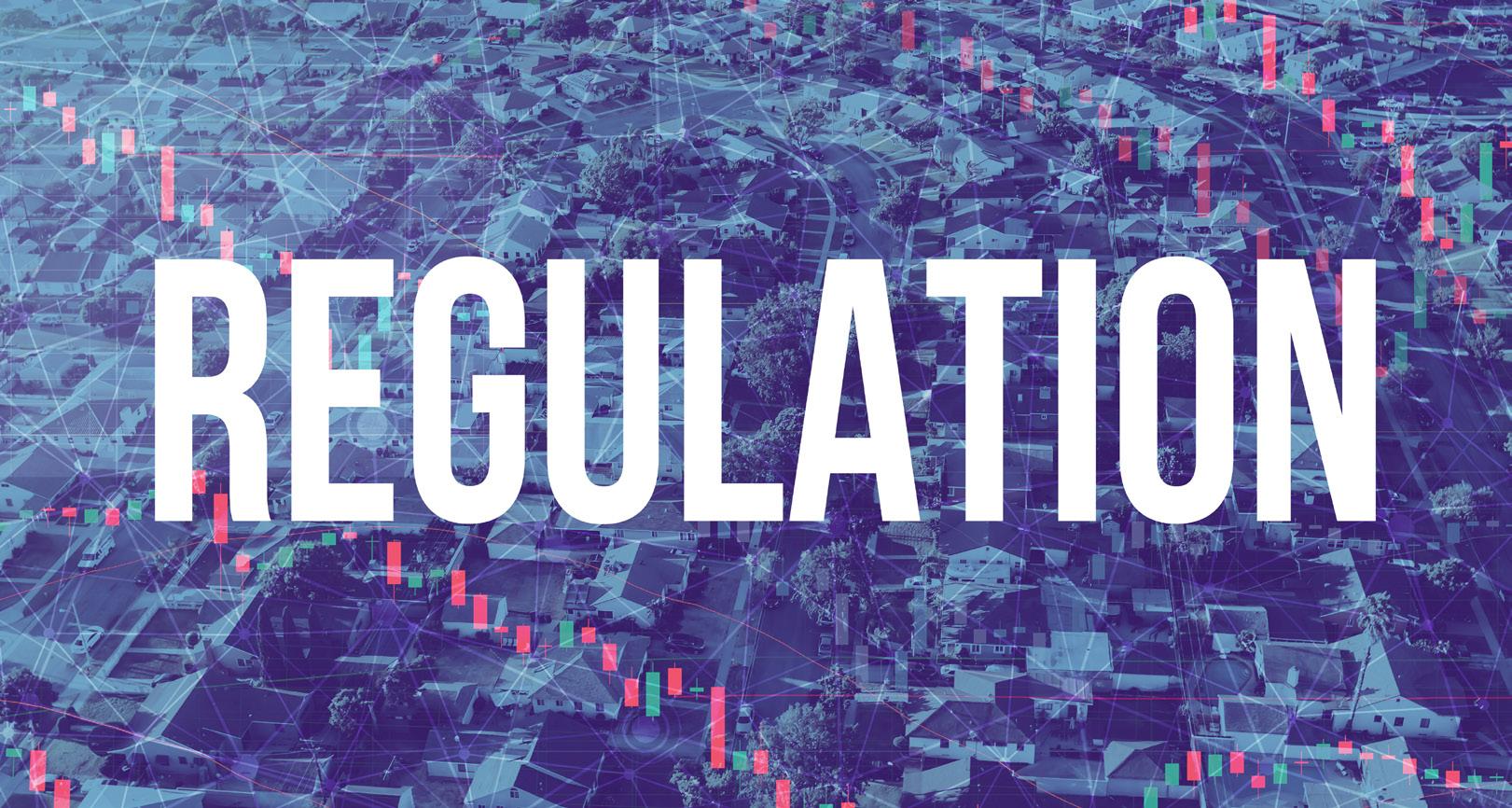
15 THE EMA MAGAZINE • ISSUE 1/2023
what it is and what it takes to comply, either due to their businesses recently being newly subject to ESOS as a result of expansion or not realising they were subject to ESOS until a non-compliance notice was served to them.
In any case, ESOS has evolved since its inception with the greatest changes being in Phase 3. The EA is stricter in demonstration of compliance and
date is on 5th December 2023, it is advisable to kickstart the process as soon as possible, to allow sufficient time to accommodate announced (althought not yet confirmed) ESOS reforms. Some of the points for consideration are:
• All private organisations with at least 250 employees OR annual turnover in excess of £44 million, and an annual balance sheet total in
• The ISO 50001 energy management standard will still have automatic compliance with ESOS
(ii) Ensure your data is accurate and verifiable
12 consecutive months of verifiable energy consumption data is required to establish the total energy consumption (TEC), the significant energy consumption (SEC) and the de-minimis. Explanation must be provided in the evidence pack if less than 12 months data has been used.
Put a system in place for obtaining the required energy data and book an energy audit if your route to ESOS compliance requires one.
(iii) Ensure the conformity of your energy audit
getting it right first time is the best approach, saving time, money and reputation. In Phase 2, a staggering 63% of companies had corrections or remedial actions following audit by the Regulators before they could be accepted as compliant. To get it right first time, you need to:
(i) Start early
Although ESOS Phase 3 compliance

excess of £38 million, are subject to ESOS
• Significant energy consumption de minimis to be reduced from 10% to 5%
• Energy Intensity Metric to be required in the ESOS report
• Detailed ‘next steps’ on the recommendations to be required in the ESOS report
Route to compliance can be through the ISO 50001 energy management standard or energy audit. If your route to ESOS compliance is energy audit, ensure your audit methodology conforms to BS EN 16247-1 or ISO 50002.
(iv) Choose an experienced ESOS Lead Assessor
Given the Environment Agency’s published report on companies subject to ESOS in Phase 2 (chart above), it is more important than ever to choose an experienced ESOS Lead Assessor to ensure your ESOS
THE EMA MAGAZINE • ISSUE 1/2023 16 FEATURES
Source: Environment Agency, ESOS Newsletter, Issue 11, January 2023
compliance. You can use the approved registers of ESOS Lead Assessors to select one. An experienced ESOS Lead Assessor will help interpret the Phase 3 requirements and provide the support needed for ESOS

Key dates for ESOS Phase 3:
• Twelve months energy data, which MUST include data for the ESOS Phase 3 qualification date (31st December 2022)
December 2023)
Author’s profile:
Abimbola Ihidero (BEng (Hons), MSc, MEIT, AMEI), is one of the EMA’s experienced ESOS Lead Assessors. She
17 THE EMA MAGAZINE • ISSUE 1/2023
by Lois Betts and Laura Bellamy
Energy Management Team Interview
What does energy management mean at Bournemouth University? Energy management means that Bournemouth University (BU) can measure, report and reduce its energy consumption to support its sustainability work to reduce its impact on the environment. Sustainability is led by our Sustainability Committee reporting into the University’s Leadership Team, and vital data comes from our energy management approach to enable both operational management of consumption and strategic investment in improvements to reduce our consumption and decarbonise the buildings. Our energy management system is combined with our environmental management system and is certified to both ISO14001 and ISO50001.
Our driving strategy is our Climate and Ecological Crisis Action Plan (CECAP), which includes a target to achieve net zero greenhouse gas emissions across all our activities by 2030/31. As we want to reduce our emissions as rapidly as possible, this is underpinned by Science Based Targets to achieve set reductions across all three scopes of emissions each year, eventually achieving a 50% reduction in actual emissions by 2030/31, compared to
our baseline year. Energy management is vital in achieving the scope 1 and 2 targets.
We have a nine-person Sustainability Team to support this, with four of us in the team working directly with Energy Management; the Sustainability Manager, Energy Manager, Energy Officer and our Sustainability and Energy Analyst. However, working with and engaging people at all levels of our organisation is vital, particularly our leadership team, Facilities Management, IT, Capital Development and building end users.
Can you explain the returnon-investment that the Energy Management team brings to Bournemouth University?

BU normally spends around £2million on energy but following the energy crisis we expect this to be around £4.2million for 2022/23 academic
year due to unit price rises. In the last year, we have made operational changes through ISO50001 monitoring and energy crisis work which have reduced consumption by around 3% (c.500MWh) and implemented energy projects saving a further 1.5% this year (c.257MWh from new solar PV, transformer upgrades, UPS upgrades and LED lighting upgrades).
As a result of these operational changes and of investment in renewables on campus since 2012 we make annual energy cost savings of around £198,000 per year. This includes a fossil fuel saving of 560MWh per year by generating our own electricity on site through solar PV, 350MWh from generating our own heat from biomass and a net saving of 563MWh from generating our own renewable heat and cooling using our ground source heat pumps.

Against our 2018/19 baseline, our carbon savings achieved so far are a 10% reduction in scope 1 emissions, and a 26% reduction in scope 2 and 64% reduction in scope 3 emissions. Overall, this represents a 36% reduction.
How are responsibilities shared in the team?
We work as an energy team to deliver the

THE EMA MAGAZINE • ISSUE 1/2023 18 CAREER & TRAINING
university’s approach to energy management. Our Sustainability and Energy Analyst provides the data foundation from the meter points and billing data to understand the consumption through overseeing our Automatic Meter Reading (AMR) system to allow us to see half hourly consumption data from around 500-meter points across our estate. Working closely with the Energy Officer and the maintenance team, we use our Building Management System (BMS) to implement building HVAC controls to
more efficient units (see project details on the right). Our Energy Manager works with our capital development team and Sustainability Manager to identify and implement larger scale projects, including on site renewable generation from solar PV, solar thermal hot water projects and ground source heat pumps. This involves using data from our Sustainability and Energy Analyst to build a case for investment.
PROJECTS (2021-2022 academic year)
Replacement of high voltage transformers with ultra-low loss transformers
minimise energy consumption, whilst retaining comfort and ventilation. We use a system of time clocks and controls to align with building opening times and planned occupancy.

The Energy Officer reports to the Energy Manager who has vast knowledge of the building mechanical operations and uses this to identify both operational control tweaks for lower energy consumption, and larger projects to implement energy efficiency improvements. Recent energy efficiency projects include replacing our HV transformers, replacing relevant lighting with LED low energy lighting and replacing UPS in comms rooms with
Our Sustainability Manager oversees our Climate and Ecological Crisis Action Plan (CECAP), which includes our plan to achieve net zero greenhouse gas emissions by 2030-31. This includes bringing together decarbonisation projects to make continual progress towards our goal. Last year, our Sustainability Manager has led the development of our campus Heat Decarbonisation Plan (HDP). This was funded through the Low Carbon Skills Fund, from which we secured nearly £100k funding to carry out technical surveys and produce the plan. The HDP will guide our approach to decarbonising heating by moving away from fossil fuel gas to lower carbon technologies.
How is information regarding energy management and the work that the team undertakes communicated to various stakeholders at the University?
One of the key stakeholders who have a large influence over how much energy the university consumes is the IT department. In fact, data centres
Following a review of the services infrastructure, it was identified that the current Tier 1 high voltage transformers were circa 32-47 years old. They had significant energy losses which accounted for 7% of the power consumed on Talbot Campus. We replaced three transformers this year with new Tier 3 high efficiency, ultra-low loss transformers which also have a new Midel biodegradable oil.
Tier 3 level transformers go beyond the minimum standard of Tier 2 required under regulations. The new units also reduce the risk of failure which would have a significant impact on operations should the existing ones failed. The reductions in energy and carbon are being measured over the coming years and could be as much as 26 tCO2e per year.
Continued to replace lighting with LED low energy lighting
It is now a standard procedure to replace any relevant lighting with LED low energy lighting. Over the last year, we installed 60 LED light fittings in Dorset House and 900 in Weymouth House. This is estimated to save around 15 tCO2e per year and approximately 35,000kWh.
UPS upgrades
Working with our IT Team we have replaced the Uninterrupted Power Supply (UPS) systems within all the IT comms rooms with new more efficient units. These have been sized to meet the needs of each area ensuring that these are operating at the most optimum efficiency. As a result, the efficiency of these systems has increased from 87% to 98% creating estimated reductions of 100,000 kWh and 26 tCO2e per year.
19 THE EMA MAGAZINE • ISSUE 1/2023
consume around 10% of campus electricity. Our Sustainability Manager is the chair of our Sustainable IT group which enables collaboration on energy saving projects. For example, in 22/23 IT are rolling out a project to reduce energy consumption in data centres reducing the amount of equipment needed and replacing it with lower consuming devices. This will contribute to our goal of delivering a year-on-year energy consumption reduction of 15% for data centres and comms rooms.
For staff and students on the ground, we use a variety of communications routes to share progress. Our website and social media are regularly updated with achievements and opportunities for students and this includes a dashboard to show live energy generation data from the majority of our solar PVs. Our team is represented at staff induction, student fairs and open days. In the last year, we have encouraged sustainable and energy saving behaviour via the Green Rewards staff engagement platform, events such as our Climate Action Month and a student volunteering programme (Climate Action Student Team).
Does the University offer any energy or sustainability training to the Sustainability Team or wider staff?
The Sustainability Team’s development is encouraged by the university, for example our Sustainability Manager
Lois has completed her MSc in Green Economy at BU with a distinction and our Energy Officer Laura is currently studying the Energy Institute’s level 2 Energy Management course, funded by BU. We regularly attend online seminars and training to support our development including through the Energy Managers Association, the EAUC, IEMA and AUDE. For staff across BU, we offer Carbon Literacy training and have trained more than 80 staff to be carbon literate and 49 students so far. This includes a section about what BU are doing to reduce our carbon footprint and we have found the Carbon Literacy
benchmarking and awards. In 2022, the wider BU Sustainability Team were awarded the BU Vice Chancellors Award for Enriching Society. This recognised the impact that our sustainability work has across BU and included staff across BU who contribute through our Sustainability Committee, including academics, IT, estates, marketing and our students’ union. Our energy and sustainability approach was also recognised through The Times Higher Impact Awards in 2021 where we were awarded the DataPoints Merit Award This was in recognition of our own action in areas of energy efficiency and
Project a great way to reach staff and engage them in coming up with their own ways to reduce their own and BU’s carbon footprint.
Are the team’s achievements celebrated by the University?
The team’s achievements are recognised both internally and externally through
sustainability as well as environmental education and net zero carbon commitments. Through this, BU were singled out by the judges in recognition of our data and evidence submitted as going the extra mile on the issue.
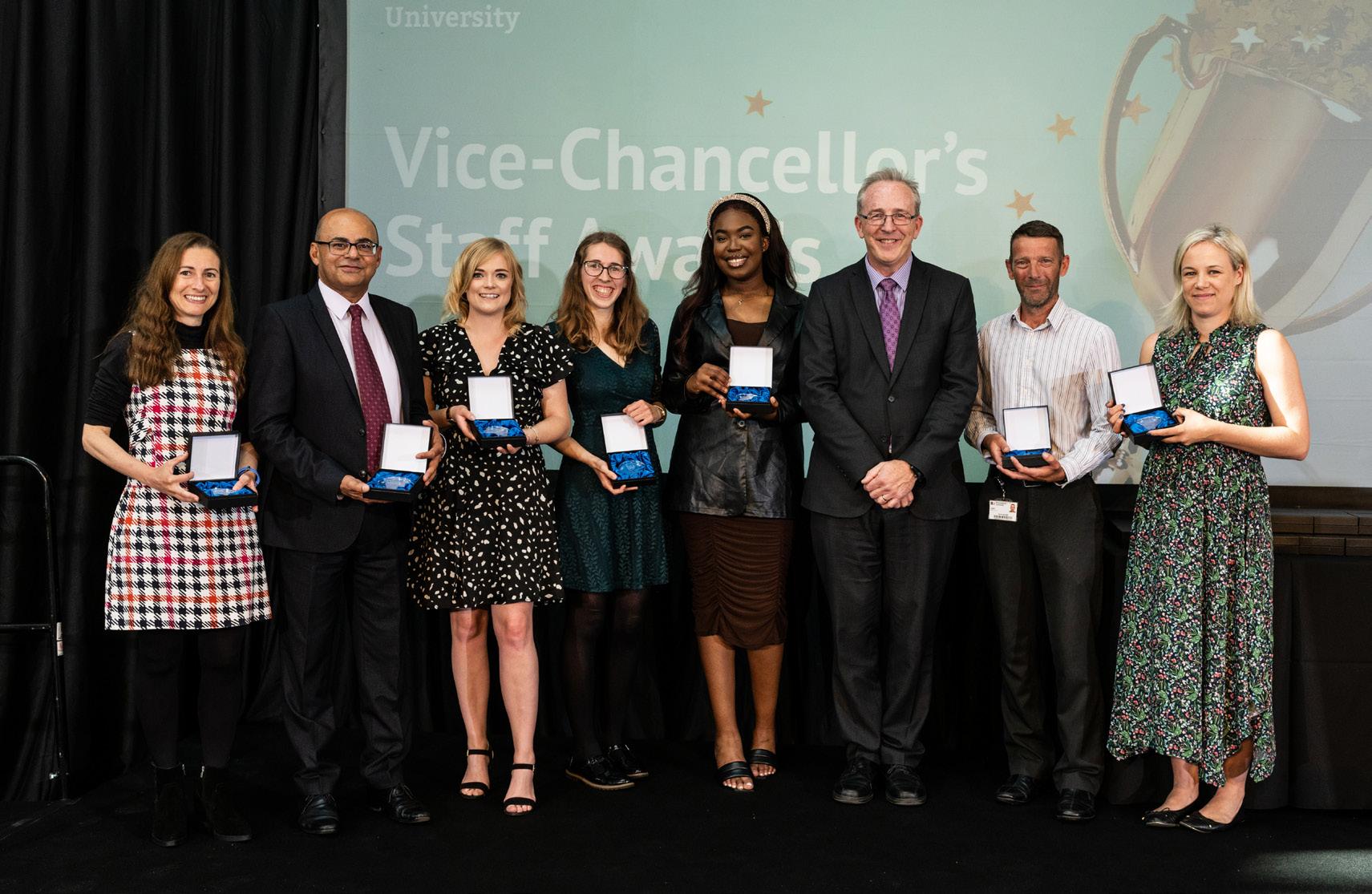
What are the plans for this year?
We have committed to achieving net
THE EMA MAGAZINE • ISSUE 1/2023 20 CAREER & TRAINING
FROM LEFT: Elena Cantarello (Principle Academic in Life and Environmental Sciences), Zulfiqar Khan (Professor of Design Engineering and Computing), Emma Davies (Student Opportunities Manager, SUBU), Eleanor Wills, (Sustainability Support Officer), Toluwa Atilade (Students Union, VP Welfare and Communities), John Vinney (Vice Chancellor), Dave Archer (Energy Manager) and Lois Betts (Sustainability Manager)
zero greenhouse gas emissions by 2030-31 in our Climate and Ecological Crisis Action Plan. This includes specific actions to use technology to reduce our emissions in our existing buildings and in capital development. For the coming year, we are developing our Heat Decarbonisation Plan which will guide our investment in low carbon heating and will make a significant improvement to our scope 1 carbon emissions. We have already identified projects for three of our buildings for installation of air source heat pumps on campus, which could save around 1.2GW of gas (while using 400MWh of electricity) annually. Further solar PV installations will increase our onsite renewable generation by around 150MWh next year. Together these projects should save us 162tCO2e in the first year of operation. Our Heat Decarbonisation Plan will identify further projects to contribute to achieving net zero by 2030-31.
We plan to continue our energy efficiency work both operationally through close control of our BMS and through projects such as replacing the remaining lighting at Talbot Campus



with LED lighting fittings. A challenge for us going forward is how we balance our energy reduction work with increased electricity usage from on site electric vehicle charging as we add more charging points on site this year and in our transition away from gas to electricity. To find out more about the BU sustainability and energy work visit https://www.bournemouth.ac.uk/ about/sustainability
Authors’ profiles: Lois Betts leads the sustainability team at Bournemouth University where she oversees the delivery of BU’s commitment to net zero GHG emissions by 2030/31. Innovation is a strong theme for Lois, and in 2022 she created the Eco Entrepreneur Fund which seeks to support students and graduates to launch or grow their eco business ideas. Laura Bellamy is the Energy Officer at Bournemouth University, having previously been the Sustainability and Energy Analyst. Laura implemented the monitoring and measuring of energy consumption at BU as part of the ISO50001 energy management system and enjoys using data to find ways to save energy and carbon.
PROJECTS (2021-2022 academic year) Passive cooling trial for comms room
Working with IT Services, BU are trialling a passive cooling system in the comms room of Weymouth House. The system is designed to utilise outside air to cool the space minimising the need for cooling via air conditioning. Initial savings from portable metering show that the reduction in energy was 95%. Additional benefits beyond energy reductions are the reduced maintenance requirements related to air conditioning. Monitoring for this trial is continuing and further opportunities for more comms rooms are being investigated. These will look at options to use outside air to cool or to recover this heat and reuse it within the building.
New solar PV array for Jurassic House
Jurassic House is home to our data centre on Talbot Campus. In December 2021, it became the 7th building of ours to have solar panels installed. The new system is expected to save over 5 tonnes of CO2e each year, equivalent to two return flights to New York from the UK. You can read more about this here.
21 THE EMA MAGAZINE • ISSUE 1/2023
My Role in Tackling Climate Change

The professionals in energy management, sustainability and environmental roles play a key part in organisations’ plans to deliver on energy efficiency and Net Zero targets. By performing their everyday roles, investing in professional development and exchanging of ideas and experiences with others, they are contributing to tackling the risks of climate change on organisational as well as national level. With all the varied roles and tasks, we are keen to showcase our members’ skills and day-to-day tasks.
In this issue, we have asked Hayley Williams about her role as the Sustainability Manager (Built Environment) at the John Lewis Partnership.
What attracted you into the industry?
I’ve always had a passion for our environment. This passion and interest are why I opted to study Geography at school, and then a BSc (Hons) in Geography & Environmental Management. After graduating, I started work in the industry, yet was keen to develop my knowledge further. So, I studied for a MSc in Climate Change & Sustainable Development which set me up to work within the sector, and really support our shift to a sustainable future.
How have you started and progressed through the industry?

My first industry relevant experience was as an intern at a solar PV installer when the Feed In Tariff was in full swing. This gave me initial exposure to the renewables market, with an understanding of the technology challenges, as well as the financial mechanisms put in place to support the adoption of such technologies. From there, I have held varying roles within

the energy and sustainability space, most recently on client side overseeing estates through the sustainability lens.
What does your current role entail?
In my current role as the Sustainability Manager (Built Environment), at the John Lewis Partnership, I have been responsible for developing our Responsible Property Framework. This is our internal framework to ensure we are upholding our Partnership values of working in Partnership for a Happier World. It is applicable to all our buildings, new and old, and comprises of the following themes: Climate Change; Health & Wellbeing; Nature & Biodiversity; Resource Use; and SocioEconomic.
In addition to this, I am also responsible for overseeing our carbon reporting and net zero roadmap, for our building related emissions (i.e., predominantly Scope 1 and 2). We have a
commitment to reduce our operational carbon footprint to zero by 2035, and we are well on that journey.
We are also currently going through the process of setting Science Based Targets, involving greater measurement of our scope 3 emissions, and setting relevant targets. From a buildings’ perspective, it is requiring us to get a detailed understanding of the embodied carbon within all our building related projects. This is still very much a developing area, and is something we will be looking at in greater detail over the coming months.
THE EMA MAGAZINE • ISSUE 1/2023 22 CAREER & TRAINING
by The Energy Managers Association
In your opinion, what role does a Sustainability Manager as a whole play in tackling climate change?
Much of what being a Sustainability Manager involves, is around bringing colleagues on a journey and getting their buy in. Ultimately, to achieve the bold aspirations many businesses have set themselves, it’s not just down to the Sustainability team to deliver - all employees need to be engaged and understand the part they can play.
What are the main challenges in tackling climate change/ delivering Net Zero targets at your organisation?
The John Lewis Partnership is a large organisation, with about 80,000 Partners and lots of moving parts. With this, there are often competing initiatives for funding, which can make it challenging to deliver sustainability and net zero related projects. Fortunately, our sustainability aspirations are very much linked to the Purpose of the Partnership, enabling us to place many
heightened everyone’s awareness to the value of energy. This has enabled us to have an even greater effort on reducing energy consumption across all the Partnership buildings. Ultimately this has reduced our carbon footprint, particularly through the winter months where we have reduced gas consumption.
What projects will you focus on this year?
Over the next year, I am going to be working on developing our plans around capturing embodied carbon data for the materials we specify within our buildings. This poses a number of challenges as suppliers don’t necessarily always have this information, so we will be looking to work closely with our suppliers.
Another area of focus for 2023 is to embed the Responsible Property Framework further within the Partnership. Working with both internal and external stakeholders to see where further opportunities lie.
mean different things to different people. I think it’s important to find which particular areas within sustainability interest you, and focus then on finding somewhere you can work in a relevant role to gain experience.
No matter what your role is within sustainability, sustainability related projects and strategies often involve changing how we do things. Change can take time, so it is important to ensure you have the tools to be resilient and lots of patience!

Author’s profile:
Hayley is a Chartered Energy Manager and an accomplished sustainability professional, having held a range of sustainability and energy roles since 2010. This has included working for a renewable technology installer, an energy supplier, and an architectural practice, but the majority of her experience has been working client side to embed sustainable strategy and behaviours.
23 THE EMA MAGAZINE • ISSUE 1/2023



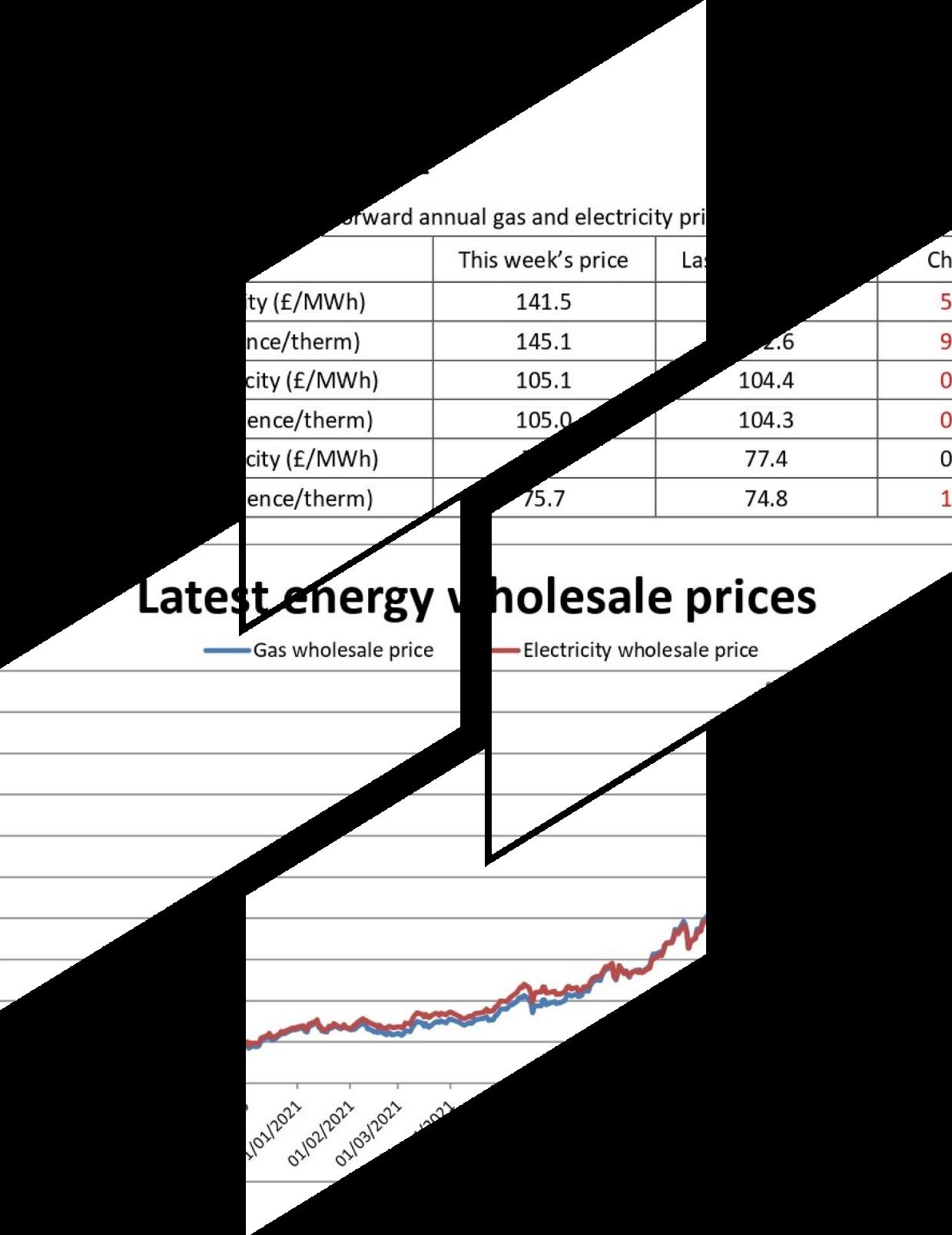




EMA ENERGY MARKET REPORT 3 MONTHS SUBSCRIPTIONS AVAILABLE: 6 MONTHS 12 MONTHS Email: ema.team@theema.org.uk Website: www.theema.org.uk/energy-market-report/
by Kirsty Rice, Environmental Lead Manager at JTI UK

Going Net Zero with our employees
BACKGROUND
JTI is Japan Tobacco International, a subsidiary of JT Inc. and a leading international tobacco and vaping company, with operations in over 70 countries and 48,000 employees globally. In the UK, there are over 500 employees across the head office, distribution centre and field-sales operations.
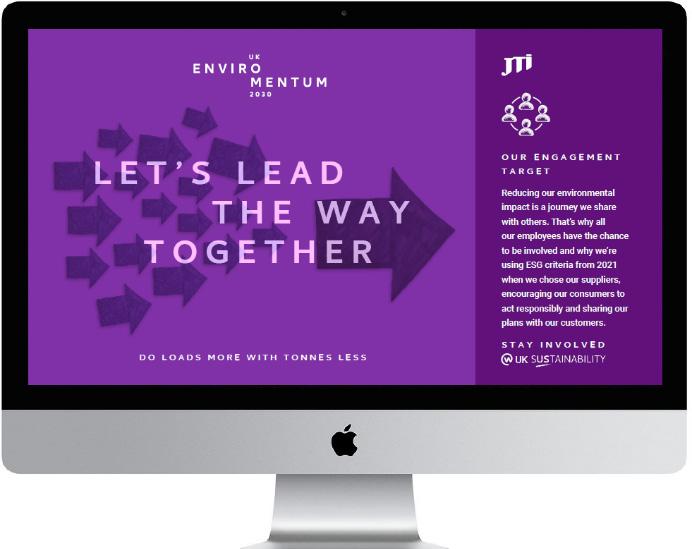
Sustainability is a key part of the decision-making and the way we behave as a business. Globally, we have committed to go Net Zero by 2050, starting with carbon neutral operations by 2030. In the UK, we have a Sustainability Team consisting of 5 employees to deliver our sustainability ambitions, covering environment, community and the embedding of sustainability as business as usual.
EMBEDDING RESPONSIBLE BUSINESS
Back in 2020, we carried out an employee survey, which highlighted our employees are keenly interested in the environment, with 85% stating that they wanted to work for an environmentally responsible business and expected the business to demonstrate this.
We were lucky that we didn’t have to start from scratch and that, as a Sustainability Team, we already had great engagement with our employees since 2008, when the company’s
community investment programme was set up and employees begun to volunteer their time for charity. This employee commitment has been a great platform to develop our wider sustainability ambition, including emissions reductions.
We started by engaging with our employees through our annual conference, running workshops and developing new priorities. We worked 1:1 with colleagues, departments and senior management to understand what was important to them and how we could best align the right kind of environmental improvements and embed sustainability.
Although we have global targets on emissions and other impacts, we specifically developed something for the UK which would feel meaningful and tangible for our employees. It was signed off and is now governed by our senior management team, the target delivery is managed
through our Environmental Task Force and the actions themselves through the Task Force leads or relevant department. Having this sense of ownership and the governance around the delivery of the plan absolutely helps with making things happen.
Our UK Environmental Plan, covers emissions, energy, waste, water and engagement. Having a range of topics means that employees can focus on what matters to them or what they have control over – for instance, everyone can contribute to our recycling targets, but it will be mainly our field-sales advisers in control of how efficiently we drive our company cars.
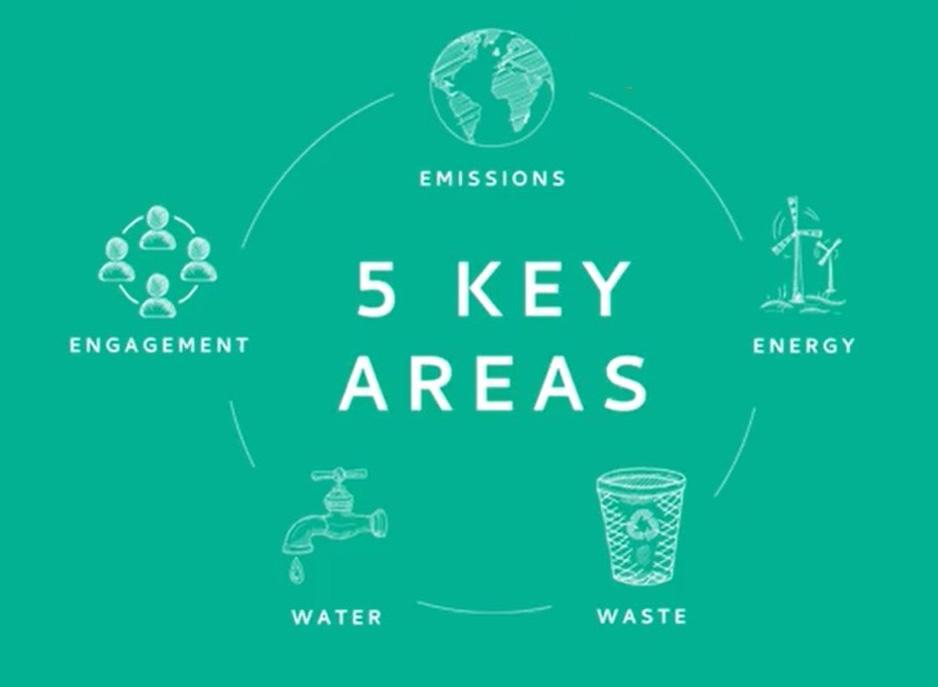
COMMUNICATION TOOLS
Good communication is key to
25 THE EMA MAGAZINE • ISSUE 1/2023 INDUSTRY FOCUS
delivering change, but it also has to be the right tool for the job. In order to deliver emissions reductions or other environmental improvements, we consider “what is the intended outcome?”. We use a number of ways to engage with our colleagues –examples in the graphic below - some communications will be simple updates, other educational, others on specific topics with key departments. We are also supported by networks such as our Sales Sustainability Champions
and departments who are critical to the delivery of our Environmental Plan through agreed specific actions which will reduce emissions, energy and waste. These departments are also represented on the Environmental Task Force which meets quarterly.
As a way of reaching out to all employees we provide updates on our intranet which highlight actions taken and recognises the positive steps taken. The communication has a distinct logo and branding so it’s easily
specific sustainability plans. We also look to do the same with our wider chain, especially our suppliers in our effort to reduce our environmental footprint, including a workshop coming up on Zero Landfill.
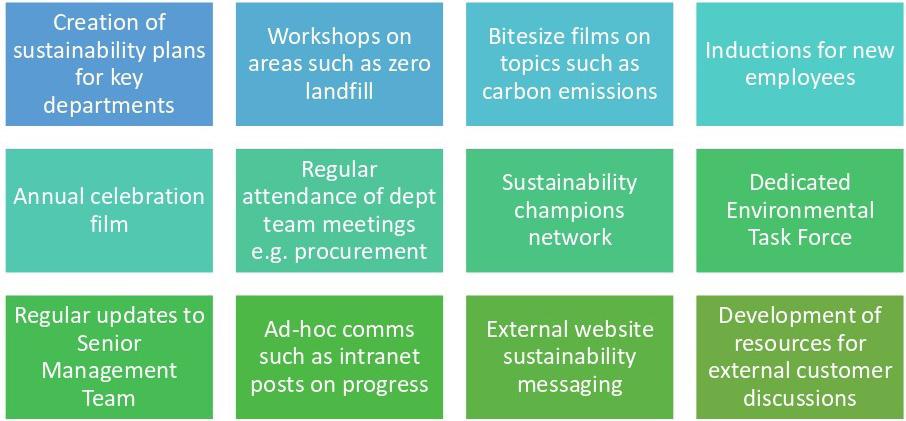
BUDGET
The budget required for a behaviour change project will depend entirely on the different tools and work involved. You can aim to budget for a simple programme with a few inhouse images and intranet messages developed
and, with a champion for each of the teams, it really helps to get the word out to a geographically diverse division. We also make good use of digital communication, especially now that we work in a hybrid way, using internal emails and an intranet to get key messages out. In the past, we have even sent SMS messages to our remote teams to update them on the Environmental Plan achievements.
FOCUSING EFFORT
We try not to run one-off campaigns as this requires a lot of work and input for a short period of reward. Instead, we focus on working with key individuals
recognisable as being related to the UK Environmental Plan.
JTI also offers employees access to offers through their employee benefits package, such as leasing an EV through salary sacrifice or off-setting their personal carbon impact.
Each year, we create an annual celebration film, which covers all the great work done, from going paperless, to starting the hybrid company car rollout, to the inclusion of ESG criteria in our tender process.
For areas which require more direct input from specific teams, we run educational workshops or develop
through a software programme like Canva or go for one which might involve, for example, something more complex such as a film of an employee talking about their contribution to emissions reductions or sustainable employee gifts such as a refillable water bottle to reduce waste.
ENVIRONMENTAL IMPROVEMENTS ACHIEVED
Much of our heating controls and lighting are automated, so the ask of our employees was never going to be a standard “switch off the light”, but over the last few years we have achieved
THE EMA MAGAZINE • ISSUE 1/2023 26
much – examples of our emissions actions are included above.
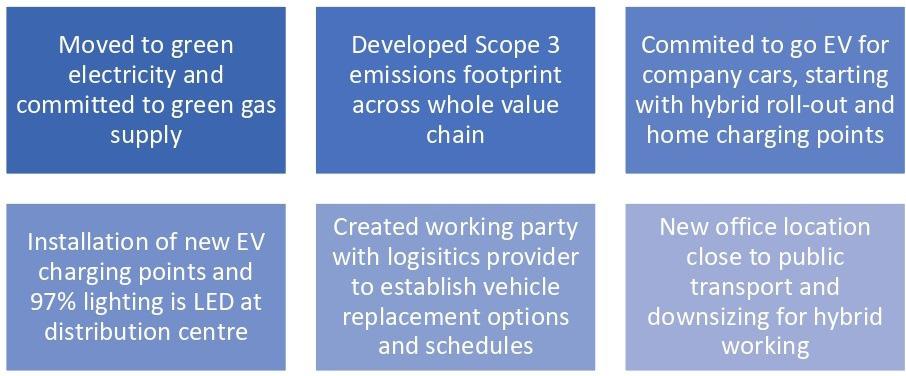
FUTURE PLANS
We will continue to support our global efforts to reduce emissions, including assessing our emissions footprint. The next step is to engage with key areas in the business and in the wider value chain to set improvement action plans. We will also be providing eco-driver training for our company car drivers to ensure they make the best use of the hybrid cars, including charging them up overnight and driving with greater efficiency.

We have some critical building projects coming up, including moving our head office this year to London, which will mean a smaller building footprint and better use of public transport. Our distribution centre will go through a greenfurb, changing the outstanding older lighting, introducing a new
heating system and future solar panels. Finally, we’ll keep the engagement going by working with the different teams across the business, keeping an open door for any ideas and suggestions, leading on key projects and supporting others where needed.
Author’s profile: Kirsty is a sustainability professional with experience of developing strategic direction, delivering practical solutions and providing day-to-day advice. Her previous experience is across commercial, public body and charity sectors. Kirsty’s role at JTI UK includes the development and delivery of an Environmental Plan, embedding environmental sustainability and ensuring compliance with environmental legislation. She is a qualified Low Carbon Assessor, ESOS Lead Assessor and PRINCE2 Project Manager.
LEARNINGS – OUR TOP 5
• Recognise that everyone has a day job to do and sustainability can sometimes feel like an extra ask for others even you may feel it isn’t. Understanding of others’ commitments and business priorities, a flexible approach and tying in sustainability so that it is meaningful to colleagues’ day jobs will help.
• As professionals, the world of energy and sustainability can seem easy, but it can be a complex area and the terminology not easily understandable to all. Using different language and adapting to your audience will gain quicker buy-in and result in change.
• Be really clear about what action your colleagues can do to make change happen. What are the top 5 things they can do, how can they do this and what support will they get?
• Sometimes the changes people are most interested in are those most visible to them (e.g., waste), but these may have little carbon impact compared to something else (e.g., reducing mileage) – however, working together on areas of interest can open the door to wider discussions.
• Clear responsibility gets things done - ensure accountability for delivery of the targets sits with the senior management team and that delivery of the actions sits with the most appropriate department.
27 THE EMA MAGAZINE • ISSUE 1/2023
INDUSTRY FOCUS
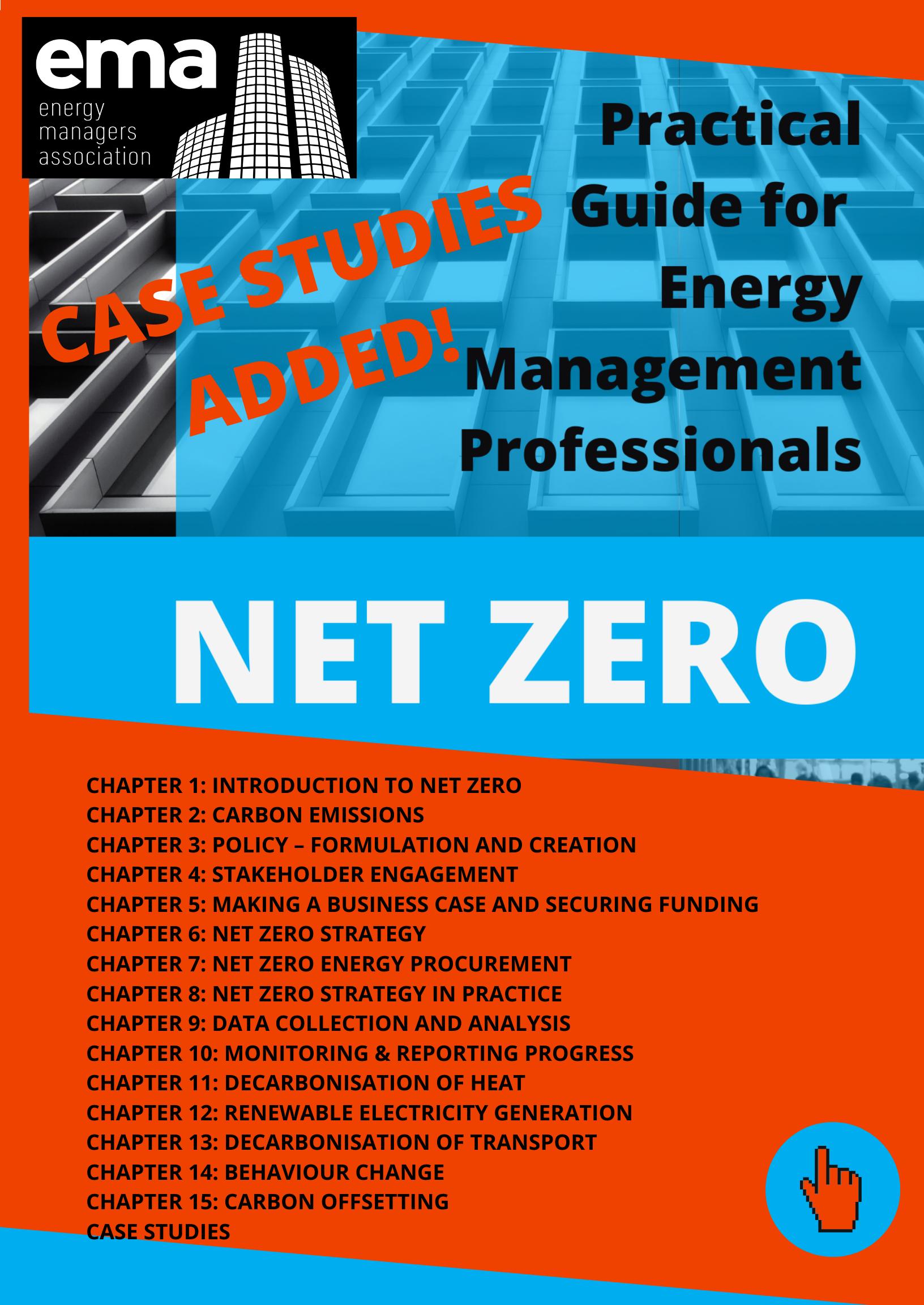 by The Energy Managers Association
by The Energy Managers Association
The Journey to NET ZERO
The UK’s national target to bring all greenhouse gas emissions to net zero by 2050 will not be easily accomplished without collective action and many organisations are preparing for their journeys to reach their own, often even more ambitious targets.
There are lessons to be learnt from every stage of this considerable task and in this issue, we have asked Sara Emmett, Climate Justice and Environment Advisor at the Diocese of Bath and Wells to share her organisation’s journey to net zero.


What is your organisation’s starting point in terms of energy use and carbon emissions?
We are still working on identifying our baselines. Our scope is wide and includes well over 500 churches and halls, around 300 properties, a large office, 2800h of glebe land and 181 church schools. Each is unique and each is managed/used by a different governing body, group or individual so assessing and recording data is an ongoing process requiring ongoing support and evolving techniques. Many of our buildings are listed which provides additional challenges to users and in planning change.
We have made significant progress in 2022 with clergy properties receiving updated Energy Performance Certificates and we achieved a good return rate on the National Churches Energy Footprint Tool for churches and schools which gives us some good baseline data from 2021- although we are aware that changes in building use during COVID has impacted some of the data we hold.
Our schools receive support in heat decarbonisation planning and specialised training for school leaders (head teachers and governors).
How do you make sure you have good data?
We are making the most of National Church Tools and provide a range of training to support those who are asked to record their establishments use. In my role, I am part of a national network of Environment Officers and the national Church Energy Advisors Network who disseminate information and share learnings. I am also part of the National Churches Diocesan Statistics group which allows us access to much wider data
sets from which we can inform our targets and planning.
How do you set up your targets and timelines, how do you prioritise your targets and gain an internal buy-in?
We formed an Environment Team which includes key members from all departments (church buildings, clergy housing, glebe land, schools, finance and communications) and is chaired by our Diocesan Secretary. Our two Bishops are committed environmentalists with our new Bishop Michael making this topic central to his service of welcome and installation last November at which he gave away 1100 hazel saplings

29 THE EMA MAGAZINE • ISSUE 1/2023 INDUSTRY FOCUS
to inspire people to take action to support our environment.
The group updated the existing Environment Action Plan which is a three-year rolling plan which we present to Bishop’s Council and Diocesan Synod (our key advisory and decision-making bodies) annually for discussion and acceptance. Each department has their own area of focus but all are responsible for its dissemination. Training programmes are in place and in planning to support and engage all staff, clergy and lay stakeholders to take action, to understand the key issues and encourage ownership of change.
Is the current energy crisis affecting energy efficiency and the delivery of carbon reduction targets at your organisation?
Everyone is affected by the energy crisis, but not in equal measure. Finances are already stretched for many churches and schools and the
price hikes have not been a welcome addition to this burden. The National Church has distributed grants to support churches at this time which has been welcomed but we will need to work together to support those in greatest hardship.
It is not yet known what impact the energy crisis may have on reduction targets - it may reduce energy use as economies are made but it may also leave less expendable finances for investment in carbon reduction.
What’s next?
As a Diocese in 2022, we achieved a Silver Eco Church Award for our diocesan offices and a Bronze Eco Diocese award from A Rocha. Eco Church is a national Christian-based award system for buildings and dioceses working hard to become more sustainable. This celebrates the breadth and depth of work being done across our churches and within the diocese. We are now

working towards a Silver Eco Diocese Award which would be a wonderful milestone. Many churches are engaged with Eco Church and we hope many more will join the journey in 2023.
The National Energy Footprint Tool opens again in January and we hope to exceed next year’s return rate from churches and schools to improve our baseline data. We are also providing two clergy houses with heat decarbonisation plans to support planning for a wider programme and provide data on costs.
Author’s profile:
Sara is a Climate Justice & Environment Advisor for the Diocese of Bath and Wells and PhD researcher at Bournemouth University, studying change management for net zero carbon in the diocesan context. She is also mum to three, wife and home maker with a love of fungi, woods, birds and all things coastal.
THE EMA MAGAZINE • ISSUE 1/2023 30
ACCESSIBLE PROMOTION OF YOUR PRODUCTS AND SERVICES


CORPORATE PATRONAGE

CORPORATE PARTNERSHIPS AFFILIATION PARTNERSHIP KNOWLEDGE PARTNERSHIP
EFFECTIVE INVESTMENT IN THE FUTURE OF YOUR BUSINESS
PROGRESSIVE APPROACH TO REACHING YOUR NET ZERO AMBITIONS
EMA
E: ENQUIRIES@THEEMA.ORG.UK T: 0203 916 5516
A N D S T R A T E G I E S C O U R S E
A s m o r e a n d m o r e o r g a n i s a t i o n s m a k e t h e i r c o m m i t m e n t s t o a c h i e v e N e t Z e r o t a r g e t s , t h i s c o u r s e e x p l a i n s w h a t N e t Z e r o c a n m e a n , h o w d i f f e r e n t i n t e r p r e t a t i o n s c a n b e a p p l i e d a n d t h e p o s s i b l e r o u t e s t o a c h i e v i n g i t I t a l s o e x p l a i n s t h e b a s i c s o f w h a t w o u l d b e i n c l u d e d i n a n o r g a n i s a t i o n ’ s c a r b o n f o o t p r i n t , a n d h o w i t c a n b e m e a s u r e d u s i n g s t a n d a r d e m i s s i o n f a c t o r s .

R E G I S T E R H E R E > >
N A V I G A T E T H E S H I F T T O N E T Z E R O
R E A C H I N G N E T Z E R O
C O U R S E

T h e c o u r s e o f f e r s a g u i d e o n h o w t o p r e p a r e f o r a n d r e a c h y o u r t a r g e t s . I t o u t l i n e s a t y p i c a l r o a d m a p t o a c h i e v i n g t h e d e s i r e d t a r g e t s a n d p r a c t i c a l m e a s u r e s t o a c h i e v e t h e m . I t h i g h l i g h t s w h e r e t h e c a r b o n i m p a c t c a n c o m e f r o m , h o w t o c r e a t e a s t r a t e g y f o r r e d u c t i o n o f e m i s s i o n s , i d e n t i f i c a t i o n o f t h e p r a c t i c a l m e a s u r e s n e e d e d a s w e l l a s a u d i t i n g a n d v e r i f y i n g p r o g r e s s .

R E G I S T E R H E R E > >
THE EMA MAGAZINE • ISSUE 1/2023 32
Z E R O F U N D A M E N T A L S
N E T
F O R T H E L A T E S T D A T E S V I S I T W W W . T H E E M A . O R G . U K















 By Lois Betts and Laura Bellamy
By Lois Betts and Laura Bellamy







 By Hayley Williams
By Hayley Williams




 by Rachel Feeney, Rebecca Smart, Anonymous Sustainability Consultant and Victoria Limbrick
by Rachel Feeney, Rebecca Smart, Anonymous Sustainability Consultant and Victoria Limbrick









































 by The Energy Managers Association
by The Energy Managers Association









